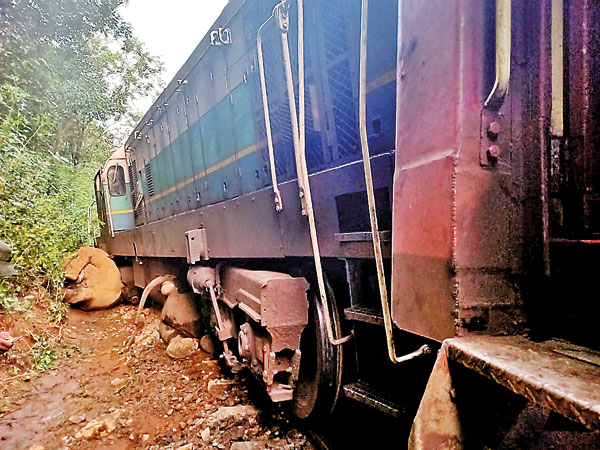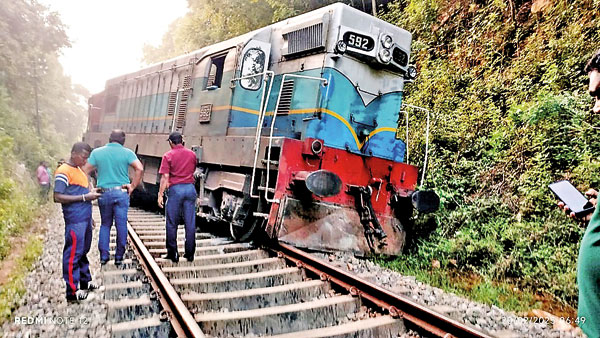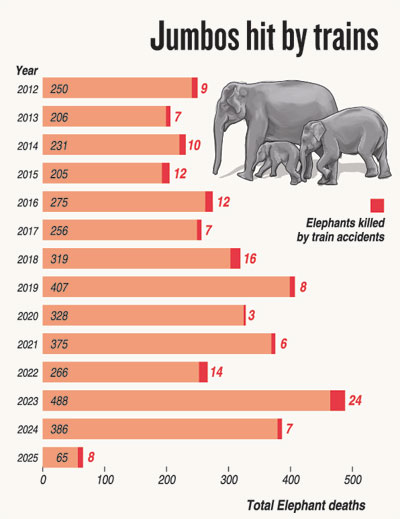News
Tragic multiple deaths of elephants in rail accident sheds light on recurring issue
View(s):By Tharushi Weerasinghe
Investigations into the train accident that killed most of a herd of elephants on Thursday began yesterday with a site inspection by officials of the Department of Wildlife Conservation and the Railway Department.
The accident, near the 141st milepost between Galoya and Hingurakgoda railway stations, occurred when the Meenagaya train collided with and killed seven elephants, including four calves and two adults. One of the calves succumbed to its injuries yesterday.
The only survivor of the herd was a pregnant elephant who was caught on video sitting by one of the calves, believed to be her calf, who died.

(Above and below) The Meenagaya train collided with and killed seven elephants.
“The time of the train is a recurring issue, and that is something we are considering changing,” said Dhammika Jayasundara, General Manager Railways. He noted that the DWC has highlighted the danger zones along the train’s route and that setting up more lighting and clearing the area are also some of the solutions under consideration. “We will remove or at least reduce the danger immediately because we understand the damage being done to one of our nation’s treasures.”
Mr. Jayasundara claimed that preliminary investigations showed no sign of speeding by the driver and that multiple elephants died because trains take time to slow down and halt. Mr. Jayasundara also noted that a private beneficiary had offered a drone to observe danger zones where the tracks go through vulnerable areas. “We are working with the DWC under their guidance for a solution, and many external and private sources have offered to help us with these measures.”
“Postmortem inquiries on the elephants that were killed are underway,” said Hasini Sarathchandra, an official from the Department of Wildlife Conservation. She told the Sunday Times on Friday that the committee’s scheduled visit to the site on Saturday would be followed by a technical committee visiting the site in two weeks to conduct a study to find long-term solutions.

Responding to a question that train collisions occur a lot in the country, she held that the department has taken many measures, like under-flushing the sides of the tracks, increasing driver awareness, and the installment of lights and thermal cameras to avert accidents.
However, conservationists argue that the issue is more deeply rooted than mere collision avoidance. “The recurring loss to this country’s biodiversity like this is due to bad national planning,” said a biodiversity conservationist and protected area specialist who wished to remain anonymous. The specialist noted that many parts of Sri Lanka’s 1500 kilometres of railways run through protected areas and the border of such areas.
“Every day there is an instance of wildlife harm somewhere along these roads and railways,” he noted, adding that a concentration of railways specifically runs through particularly wild, elephant-dense dry zones. He also held that the issue of train collisions could not be resolved by improving lighting alone.
“If that was the case no collisions would happen during the day, which they have repeatedly.” He also added that shutting down trains in a country with a high dependency on public transportation was not viable. “While big technological solutions are always being slated for discussion, and fingers are pointed at various institutions, no one stakeholder can be held responsible unitarily. The fact of the matter is that this is the price one pays for over 50 years of poor planning at the hands of political administrations.”

A special discussion was held in Parliament on Friday (20) to address the issue of wild elephants being hit by trains. Ministers Bimal Ratnayake and Dhammika Patabendi chaired the meeting, which included officials from the Transport, Environment, and Digital Ministries, as well as representatives from the Railways and Wildlife Conservation Departments.
Key measures discussed included improving track visibility in high-risk areas and using modern technologies such as digital solutions and advanced train lighting. Cabinet Spokesman Nalinda Jayatissa acknowledged past failures in addressing the issue and emphasised the government’s commitment to a scientific and sustainable solution that balances railway operations with elephant protection.
The best way to say that you found the home of your dreams is by finding it on Hitad.lk. We have listings for apartments for sale or rent in Sri Lanka, no matter what locale you're looking for! Whether you live in Colombo, Galle, Kandy, Matara, Jaffna and more - we've got them all!

